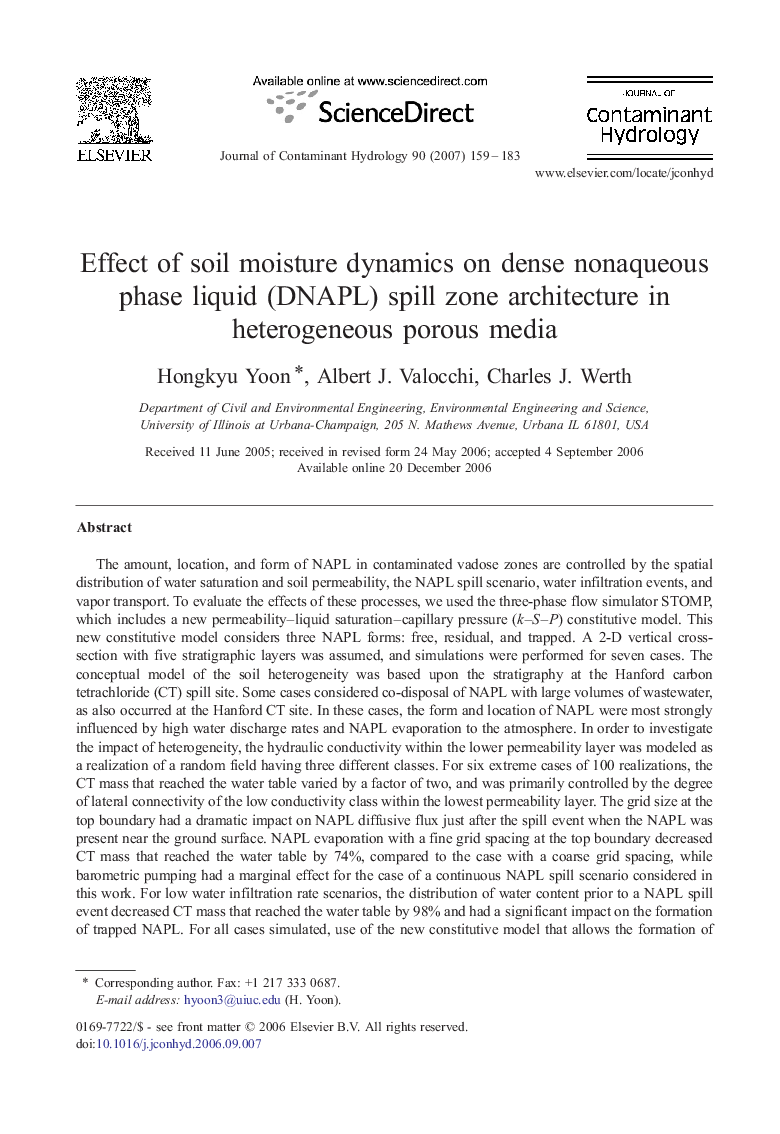| کد مقاله | کد نشریه | سال انتشار | مقاله انگلیسی | نسخه تمام متن |
|---|---|---|---|---|
| 4547579 | 1627126 | 2007 | 25 صفحه PDF | دانلود رایگان |

The amount, location, and form of NAPL in contaminated vadose zones are controlled by the spatial distribution of water saturation and soil permeability, the NAPL spill scenario, water infiltration events, and vapor transport. To evaluate the effects of these processes, we used the three-phase flow simulator STOMP, which includes a new permeability–liquid saturation–capillary pressure (k–S–P) constitutive model. This new constitutive model considers three NAPL forms: free, residual, and trapped. A 2-D vertical cross-section with five stratigraphic layers was assumed, and simulations were performed for seven cases. The conceptual model of the soil heterogeneity was based upon the stratigraphy at the Hanford carbon tetrachloride (CT) spill site. Some cases considered co-disposal of NAPL with large volumes of wastewater, as also occurred at the Hanford CT site. In these cases, the form and location of NAPL were most strongly influenced by high water discharge rates and NAPL evaporation to the atmosphere. In order to investigate the impact of heterogeneity, the hydraulic conductivity within the lower permeability layer was modeled as a realization of a random field having three different classes. For six extreme cases of 100 realizations, the CT mass that reached the water table varied by a factor of two, and was primarily controlled by the degree of lateral connectivity of the low conductivity class within the lowest permeability layer. The grid size at the top boundary had a dramatic impact on NAPL diffusive flux just after the spill event when the NAPL was present near the ground surface. NAPL evaporation with a fine grid spacing at the top boundary decreased CT mass that reached the water table by 74%, compared to the case with a coarse grid spacing, while barometric pumping had a marginal effect for the case of a continuous NAPL spill scenario considered in this work. For low water infiltration rate scenarios, the distribution of water content prior to a NAPL spill event decreased CT mass that reached the water table by 98% and had a significant impact on the formation of trapped NAPL. For all cases simulated, use of the new constitutive model that allows the formation of residual NAPL increased the amount of NAPL retained in the vadose zone. Density-driven advective gas flow from the ground surface controlled vapor migration in strongly anisotropic layers, causing NAPL mass flux to the lower layer to be reduced. These simulations indicate that consideration of the formation of residual and trapped NAPLs and dynamic boundary conditions (e.g., areas, rates, and periods of different NAPL and water discharge and fluctuations of atmospheric pressure) in the context of full three-phase flow are needed, especially for NAPL spill events at the ground surface. In addition, NAPL evaporation, density-driven gas advection, and NAPL vertical movement enhanced by water flow must be considered in order to predict NAPL distribution and migration in the vadose zone.
Journal: Journal of Contaminant Hydrology - Volume 90, Issues 3–4, 20 March 2007, Pages 159–183